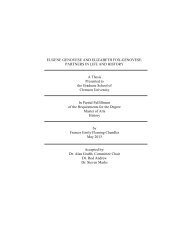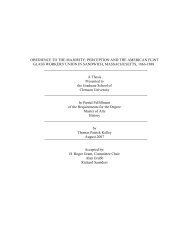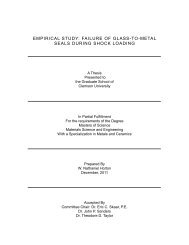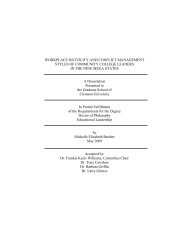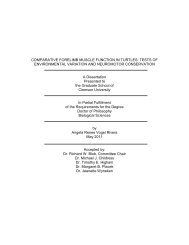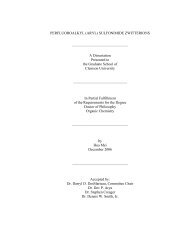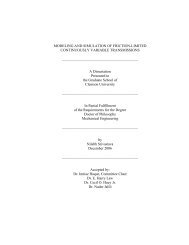FIGHTING FOR REVIVAL - Clemson University
FIGHTING FOR REVIVAL - Clemson University
FIGHTING FOR REVIVAL - Clemson University
You also want an ePaper? Increase the reach of your titles
YUMPU automatically turns print PDFs into web optimized ePapers that Google loves.
Edgefield County in particular, differed from other Southern states from the outset in its<br />
religious development. From the first settlements in Charleston, religious toleration had<br />
been the norm, and as settlers moved westward, this trend continued. Edgefield certainly<br />
fits squarely into this picture, as religious toleration and cooperation was present from the<br />
earliest settlements in the region. 87 This development process will set the stage for<br />
further analysis of how two dominant Southern ethics developed parallel to one another<br />
and ultimately became mutually influential.<br />
Evangelicalism, according to Christine Leigh-Heyrman, “came late to the<br />
American South, as an exotic import rather than an indigenous development.” 88<br />
Historians have generally agreed that the first forays of evangelicalism into the South<br />
came as part of the Great Awakening during the middle of the eighteenth century, in the<br />
form of New Light Baptists and George Whitfield’s Wesleyan Methodism. The pillars of<br />
this Protestant evangelical faith flew in the face of many existing Southern cultural<br />
customs, and initially it has been documented that this brand of religious faith was slow<br />
to gain acceptance, and was confined to the lower classes in Southern society.<br />
Though differences existed even between the different sects of Protestantism,<br />
there were common moral foundations, a specific system of values that persisted in every<br />
denomination. All were appalled by the apparent violence and licentiousness of Southern<br />
culture and the social hierarchy inherent and reinforced in the establishment of the<br />
87 Orville Vernon Burton, In My Father’s House are Many Mansions (Chapel Hill:<br />
The <strong>University</strong> of North Carolina Press, 1985), 21-28; Walter Edgar, South Carolina:<br />
A History (Columbia: <strong>University</strong> of South Carolina Press, 1998), 181-185.<br />
88 Christine Leigh Heyrman, Southern Cross: The Beginnings of the Bible Belt<br />
(Chapel Hill: The <strong>University</strong> of North Carolina Press, 1997.), 9.<br />
40




